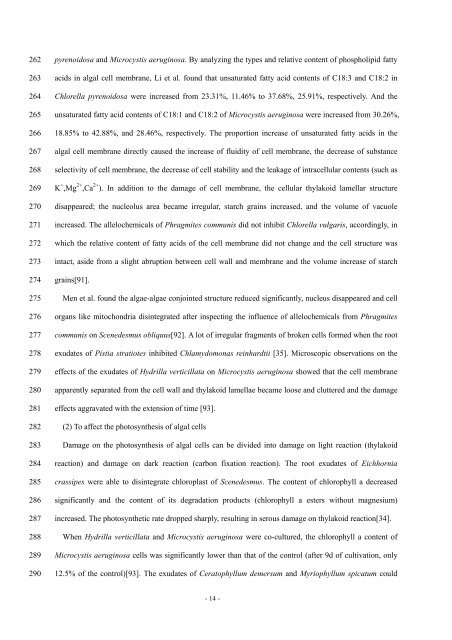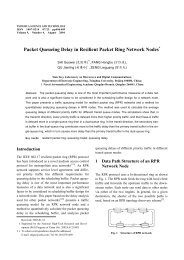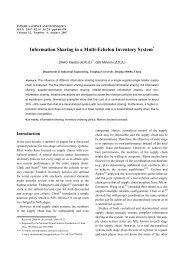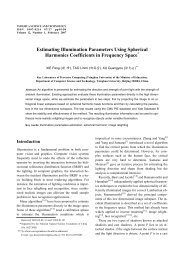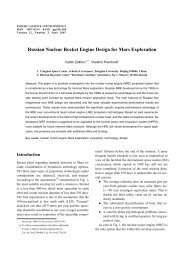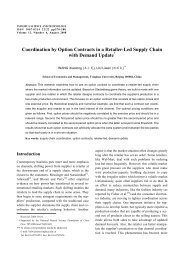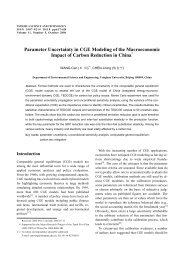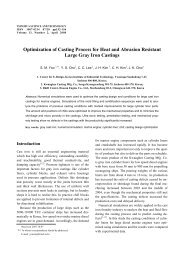Sample Paper_Submission.pdf
Sample Paper_Submission.pdf
Sample Paper_Submission.pdf
Create successful ePaper yourself
Turn your PDF publications into a flip-book with our unique Google optimized e-Paper software.
262<br />
263<br />
264<br />
265<br />
266<br />
267<br />
268<br />
269<br />
270<br />
271<br />
272<br />
273<br />
274<br />
275<br />
276<br />
277<br />
278<br />
279<br />
280<br />
281<br />
282<br />
283<br />
284<br />
285<br />
286<br />
287<br />
288<br />
289<br />
290<br />
pyrenoidosa and Microcystis aeruginosa. By analyzing the types and relative content of phospholipid fatty<br />
acids in algal cell membrane, Li et al. found that unsaturated fatty acid contents of C18:3 and C18:2 in<br />
Chlorella pyrenoidosa were increased from 23.31%, 11.46% to 37.68%, 25.91%, respectively. And the<br />
unsaturated fatty acid contents of C18:1 and C18:2 of Microcystis aeruginosa were increased from 30.26%,<br />
18.85% to 42.88%, and 28.46%, respectively. The proportion increase of unsaturated fatty acids in the<br />
algal cell membrane directly caused the increase of fluidity of cell membrane, the decrease of substance<br />
selectivity of cell membrane, the decrease of cell stability and the leakage of intracellular contents (such as<br />
K + ,Mg 2+ ,Ca 2+ ). In addition to the damage of cell membrane, the cellular thylakoid lamellar structure<br />
disappeared; the nucleolus area became irregular, starch grains increased, and the volume of vacuole<br />
increased. The allelochemicals of Phragmites communis did not inhibit Chlorella vulgaris, accordingly, in<br />
which the relative content of fatty acids of the cell membrane did not change and the cell structure was<br />
intact, aside from a slight abruption between cell wall and membrane and the volume increase of starch<br />
grains[91].<br />
Men et al. found the algae-algae conjointed structure reduced significantly, nucleus disappeared and cell<br />
organs like mitochondria disintegrated after inspecting the influence of allelochemicals from Phragmites<br />
communis on Scenedesmus obliquus[92]. A lot of irregular fragments of broken cells formed when the root<br />
exudates of Pistia stratiotes inhibited Chlamydomonas reinhardtii [35]. Microscopic observations on the<br />
effects of the exudates of Hydrilla verticillata on Microcystis aeruginosa showed that the cell membrane<br />
apparently separated from the cell wall and thylakoid lamellae became loose and cluttered and the damage<br />
effects aggravated with the extension of time [93].<br />
(2) To affect the photosynthesis of algal cells<br />
Damage on the photosynthesis of algal cells can be divided into damage on light reaction (thylakoid<br />
reaction) and damage on dark reaction (carbon fixation reaction). The root exudates of Eichhornia<br />
crassipes were able to disintegrate chloroplast of Scenedesmus. The content of chlorophyll a decreased<br />
significantly and the content of its degradation products (chlorophyll a esters without magnesium)<br />
increased. The photosynthetic rate dropped sharply, resulting in serous damage on thylakoid reaction[34].<br />
When Hydrilla verticillata and Microcystis aeruginosa were co-cultured, the chlorophyll a content of<br />
Microcystis aeruginosa cells was significantly lower than that of the control (after 9d of cultivation, only<br />
12.5% of the control)[93]. The exudates of Ceratophyllum demersum and Myriophyllum spicatum could<br />
- 14 -


